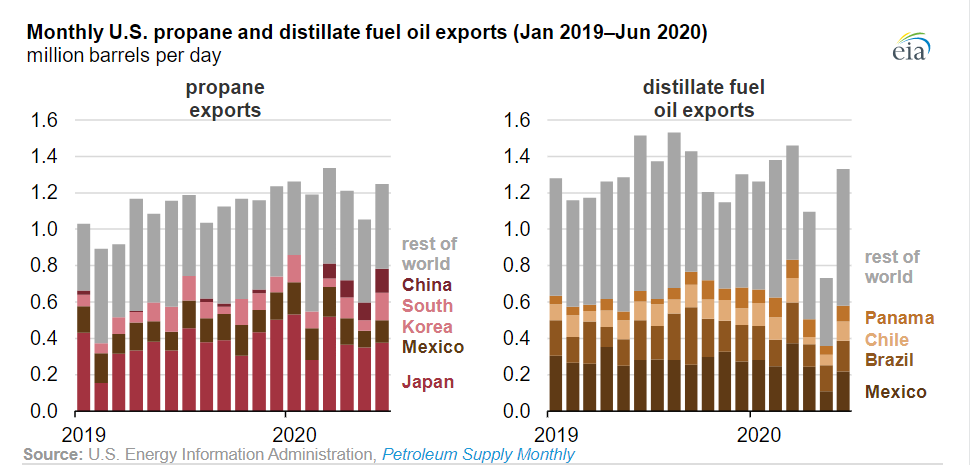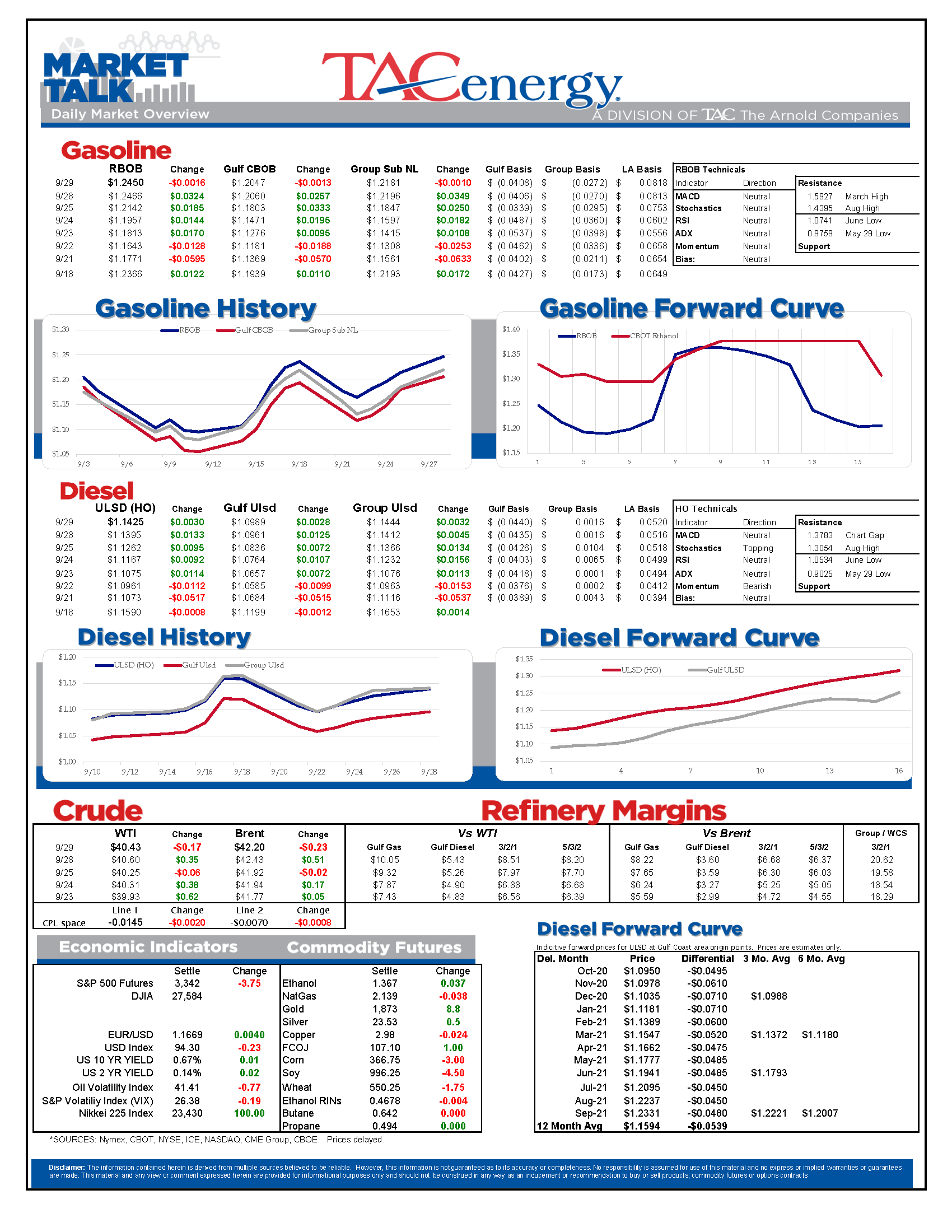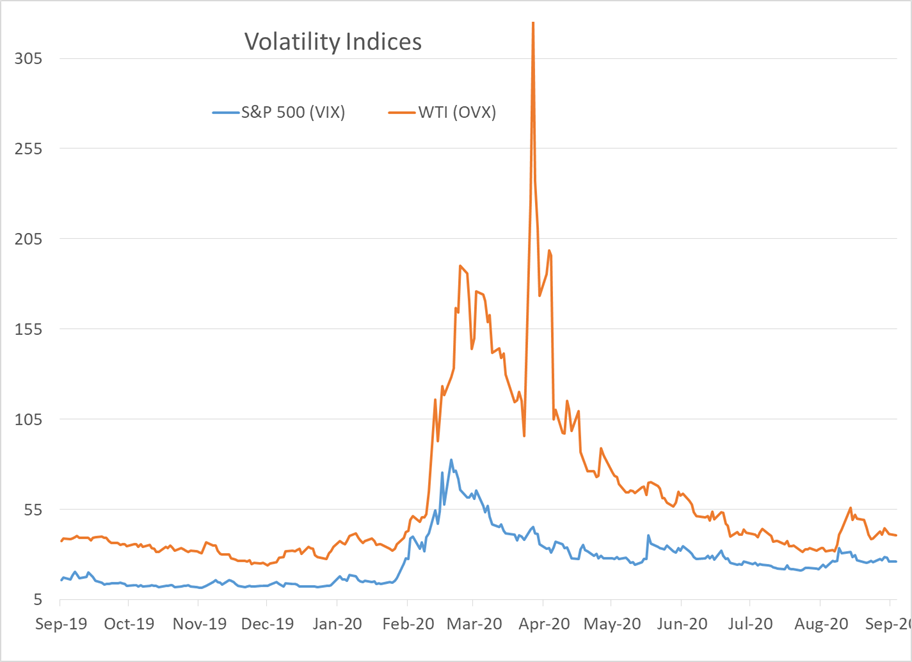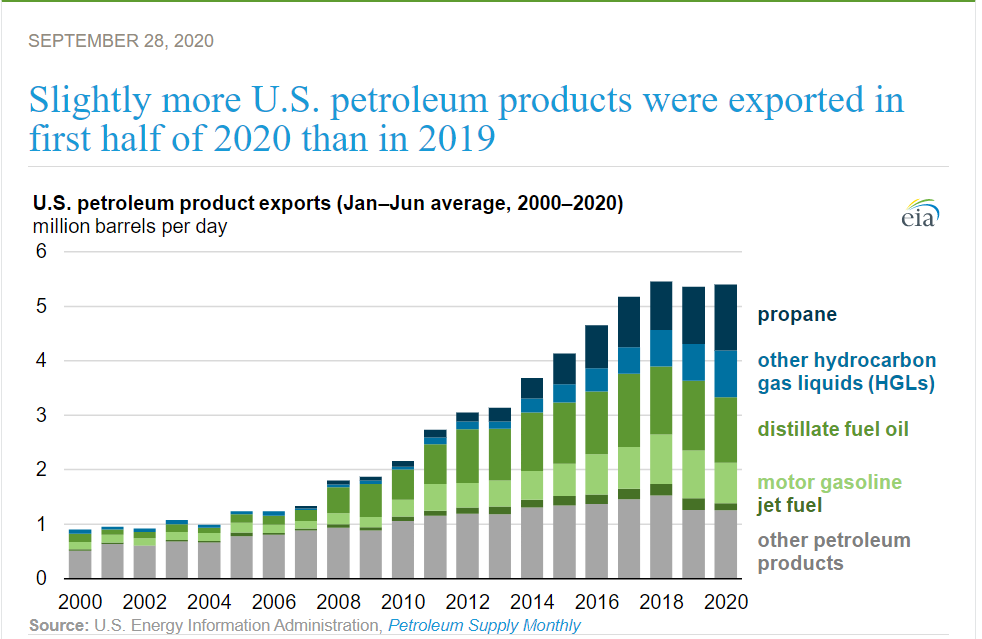Energy Complex Moves Back Into Neutral Territory

It’s another quiet start as September trading winds down, with refined products taking a small step back after four straight days of gains.
The September recovery bounce after testing the summer lows early in the month has moved the energy complex back into neutral territory on the daily and weekly charts, while the monthly charts still show more downside risk as winter approaches. Monday’s rally in gasoline highlights the complicated challenge for refiners as gasoline inventories have now returned to normal levels, while a glut of distillates remains.
The EIA Monday reported that despite the COVID-related slowdowns in gasoline, diesel and jet fuel exports, the U.S. still sent more petroleum products overseas in the first half of 2020 compared to 2019 thanks to continued growth in Propane and other HGL deliveries, primarily to Asia. While those various liquids – which are mainly a byproduct of oil and natural gas drilling – have numerous uses, the growth in demand from overseas is believed to be primarily driven by production of plastics and other industrial uses, rather than transportation fuels.
The American Trucking Association is forecasting a strong recovery in trucking activity after an unprecedented decline this year in its annual freight forecast. The report estimates a rebound of nearly five percent in trucking volumes next year, then an average growth of 3.2 percent for the following five years. If that report comes to fruition it will be welcome news to U.S. refiners struggling to find a home for their distillate streams.
As various green transition programs are becoming more mainstream in the oil industry, Rosneft is warning that the industry risks another supply and price shock on the back side of the pandemic due to lack of investment in traditional resources. The FT article notes: The 100m barrel a day pre-pandemic oil market required 3m-5m b/d of new supplies to be found each year just to keep up with depletion at existing fields.
While there’s been plenty of refinery closure and project cancellation announcements lately, the refinery formerly known as Hovensa initiated start-up of the plant in the past week, after years of delays. The company planning a new build refinery in North Dakota meanwhile is detailing some of its cutting edge technology, including using corn oil to back out some crude oil, that will make its facility the “greenest” in the U.S., which they believe will offset its limited scale.
In other non-traditional refinery news, Tesla is reportedly building a lithium hydroxide refinery in Texas, adjacent to the facility that will produce its electric-powered trucks. The move to control some of the upstream pieces of its battery production sheds light on just how complex the process of harnessing electricity on a commercial scale really is.
The EPA is challenging the idea California’s governor laid out to ban gasoline-powered-car sales in the state starting in 2035, suggesting the target (which still has to have implementation goals set by the CARB) may be illegal in addition to being impractical.
Click here to download a PDF of today's TACenergy Market Talk.
Latest Posts
Week 16 - US DOE Inventory Recap
Energy Markets Trading Quietly In The Red As Ethanol Prices Rally To Five-Month High
The Struggle For Renewable Producers Continues As A Rapid Influx Of Supply And Crashing Credit Prices Make Biodiesel
After Years Of Backwardation, Diesel Prices Have Slipped Into Contango Over The Past Week
Social Media
News & Views
View All
Week 16 - US DOE Inventory Recap

Energy Markets Trading Quietly In The Red As Ethanol Prices Rally To Five-Month High
Energy markets are trading quietly in the red to start Wednesday’s session after a healthy bounce Tuesday afternoon suggested the Israel-Iran-linked liquidation had finally run its course.
There are reports of more Ukrainian strikes on Russian energy assets overnight, but the sources are sketchy so far, and the market doesn’t seem to be reacting as if this is legitimate news.
Ethanol prices have rallied to a 5-month high this week as corn and other grain prices have rallied after the latest crop progress update highlighted risks to farmers this year, lower grain export expectations from Ukraine, and the approval of E15 blends this summer despite the fact it pollutes more. The rally in grain and renewables prices has also helped RIN values find a bid after it looked like they were about to test their 4-year lows last week.
The API reported small changes in refined product inventories last week, with gasoline stocks down about 600,000, while distillates were up 724,000. Crude oil inventories increased by 3.2 million barrels according to the industry-group estimates. The DOE’s weekly report is due out at its normal time this morning.
Total reported another upset at its Port Arthur refinery that’s been a frequent flier on the TCEQ alerts since the January deep freeze knocked it offline and damaged multiple operating units. This latest upset seems minor as the un-named unit impacted was returned to normal operations in under an hour. Gulf Coast basis markets have shrugged off most reports of refinery upsets this year as the region remains well supplied, and it’s unlikely we’ll see any impact from this news.
California conversely reacted in a big way to reports of an upset at Chevron’s El Segundo refinery outside of LA, with CARBOB basis values jumping by more than a dime. Energy News Today continued to show its value by reporting the upset before the flaring notice was even reported to area regulators, proving once again it’s ahead of the curve on refinery-related events. Another industry news outlet meanwhile struggled just to remember where the country’s largest diesel seller is located.
Click here to download a PDF of today's TACenergy Market Talk

The Struggle For Renewable Producers Continues As A Rapid Influx Of Supply And Crashing Credit Prices Make Biodiesel
The sigh of relief selloff continues in energy markets Tuesday morning, with gasoline prices now down more than 20 cents in 7 sessions, while diesel prices have dropped 26 cents in the past 12. Crude oil prices are within a few pennies of reaching a 1 month low as a lack of headlines from the world’s hot spots allows some reflection into the state of the world’s spare capacity for both oil and refined products.
Gasoline prices are trading near a 6-week low this morning, but still need to fall about another nickel in order to break the weekly trendline that pushed prices steadily higher since December. If that trend breaks, it will be safer to say that we saw the end of the spring gasoline rally on April 12th for the 2nd year in a row. Last year RBOB futures peaked on April 12 at $2.8943 and bottomed out on May 4th at $2.2500. The high (at this point) for this year was set on April 12th at $2.8516, and the low overnight was $2.6454.
It’s not just energy commodities that are seeing an unwind of the “flight to safety” trade: Gold prices had their biggest selloff in 2 years Monday and continue to point lower today. Just how much money poured into commodities in the weeks leading up to the direct confrontation between Israel and Iran is unclear, but we have seen in year’s past that these unwind-events can create a snowball effect as traders can be forced to sell to cover their margin calls.
Supply > Demand: The EIA this morning highlighted the record setting demand for natural gas in the US last year, which was not nearly enough to offset the glut of supply that forced prices to a record low in February. A shortage of natural gas in Europe was a key driver of the chaotic markets that smashed just about every record in 2022, and an excess of natural gas supply in Europe and the US this year is acting as a buffer, particularly on diesel prices.
The struggle for renewable producers continues as a rapid influx of supply and crashing credit prices make Biodiesel, RD and SAF unprofitable for many. In addition to the plant closures announced in the past 6 months, Vertex Energy reported Monday it’s operating its Renewable Diesel facility in Mobile AL at just 50% of capacity in Q1. The truly scary part for many is that the $1/gallon Blender's tax credit ends this year and is being replaced by the “Clean” Fuel production credit that forces producers to prove their emissions reductions in order to qualify for an increased subsidy. It’s impossible to say at this point how much the net reduction will be for domestic producers, but importers will get nothing, and at current CI values, many biodiesel producers may see their “blend credit” cut by more than half.
Click here to download a PDF of today's TACenergy Market Talk.



